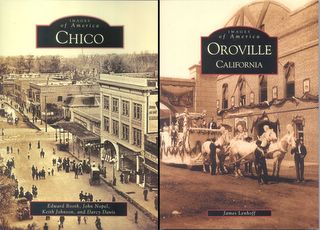
Pictorial volumes on Chico and Oroville from those well-versed in local history
By DAN BARNETT
Kudos to Arcadia Publishing (www.arcadiapublishing.com) for its extraordinary paperback series that showcases vintage black and white photographs from towns across the country.
Local historians write the introduction and captions and each book, though presented in an appealing uniform format, has its own personality and focus.
It's tempting to devote individual columns to each of the volumes of north state interest, but, space being of the essence, I'll do periodic roundups instead. That in no way mutes my advice: If you have any interest in area history, buy these books and send a thank-you note to the publisher.
"Images of America: Chico" ($19.99, published in 2005), combines the words of Edward V. Booth (former Enterprise-Record staff member and son of longtime E-R staffer Eddie Booth, who died in 1994) with the pictorial and historical expertise of Keith Johnson of the Butte County Historical Society and the unmatched John Nopel who, it can be said, has forgotten more about Chico than most of us will ever know.
Photographer Darcy Davis has added special attraction with "what does it look like now?" pictures of old-time Chico. (The E-R's Steve Schoonover, Laura Urseny and Ari Cohn are also credited.)
The book focuses primarily on Chico's grand old buildings and thoroughfares, and the then-and-now photographs are mesmerizing. Several pages are devoted to City Plaza in its various transformations, and the text is so up-to-date the current construction is also mentioned. You can look down The Esplanade of the 1920s and then see the same boulevard in 2005; there's Bidwell Mansion in 1868, just after it was finished, and then there's the mansion as it looks today. The most stunning change, though, is from the 1872 picture of Chico's Town Hall building, between Third and Fourth streets, to today's site, occupied by The Underground and the Towne Lounge, with not a politico in sight.
There's the 1916 shot of West First Street with the steps of Chico (now Bidwell) Presbyterian Church on the right and the steps to what would become Tres Hombres restaurant on the left -- and actual inches of snow on the ground! There are the buildings that became Chico State University; an aerial view of Diamond Match in 1918; and a picture of something the caption says "most people likely never knew existed": a rail line on West Fifth to the Sacramento River which "carried streetcars taking workers from Chico to the new sugar-beet processing plant that opened in Hamilton City in 1907." (PassengerS had to cross the river in a boat.)
There aren't many boats in "Images of America: Oroville, California" ($19.99, 2001) but there are a lot of gold dredgers, trains and bridges. Author James Lenhoff (whose own home on Montgomery Street, built in 1878 and "purchased and restored by the author and his wife in 1961," is among those pictured) has an abiding love of Oroville and its people. Lenhoff includes engravings of early scenes and is given to identify, by name if possible, those pictured in the many photographs.
The last chapter, "Luminaries and Modern Times," gives us images of Forty-niner Captain Ralph Bird, who "has been called the Father of Oroville because he laid out the new city of Oroville in 1855, naming the streets after himself and other contemporary associates"; George C. Perkins, "Oroville's most outstanding pioneer, going on to be elected governor in 1879" and later senator; Thomas Alva Edison, who "in 1879 ... established the Edison Ore Milling Company in Oroville to promote his gold-separating machine and seek platinum for his new light bulbs ... (who) visited Oroville at least once"; and Erle Stanley Gardner, the creator of Perry Mason, who "was raised in Oroville" and whose "father was a gold dredging engineer."
Though Oroville Dam played a large part in the life of the town in the 1950s and '60s, and there is a stunning picture when work was finished in 1968, most of the book's pictures are devoted to mining, the development of downtown and Oroville's schools and houses of worship. Oroville boys marched off to war in 1917; "the first statewide Citrus Fair was held on the courthouse lawn in downtown Oroville in 1887; and there is a picture of the historic Union Hotel, begun in 1864 on the corner of Myers and Montgomery Streets.
These books open historical doors and it is wise that we enter.
Dan Barnett teaches philosophy at Butte College. To submit review copies of published books, please send e-mail to dbarnett@maxinet.com. Copyright 2006 Chico Enterprise-Record. Used by permission.
No comments:
Post a Comment